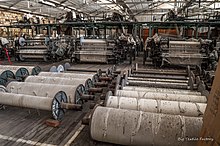User:Ajones50/Byssinosis
| This is the sandbox page where you will draft your initial Wikipedia contribution.
If you're starting a new article, you can develop it here until it's ready to go live. If you're working on improvements to an existing article, copy only one section at a time of the article to this sandbox to work on, and be sure to use an edit summary linking to the article you copied from. Do not copy over the entire article. You can find additional instructions here. Remember to save your work regularly using the "Publish page" button. (It just means 'save'; it will still be in the sandbox.) You can add bold formatting to your additions to differentiate them from existing content. |
Article Draft[edit]
Lead[edit]

Byssinosis differs from other occupational lung diseases as it is caused by inhalation of cotton dust and other fibrous dusts.[1]
Current smokers are also at risk for developing byssinosis or having complications relating to byssinosis. [2]
Byssinosis differs from COPD, and other respiratory diseases by exposure. Where COPD is brought on by smoking and secondhand smoke, byssinosis develops from dust or other fibrous exposures.
NEED TO PUT THIS SENTENCE IN:
Cotton or jute dust in the workplace atmosphere comes from the processing of cotton and other fibrous materials. The process of cotton and other fibrous material can release dust particles of varying size in addition to other ground-up plant matter, soil, fungi, and non-cotton matter.[3]
History ( added)[edit]
In 1978, the Occupational Safety and Health Administration (OSHA) developed a cotton dust standard act which aimed to prevent occupational respiratory disease, such as byssinosis, through medical monitoring of employees.[4] OSHA regulators hoped that this standard would help decrease the impact of dust exposure of employees and reduce occupational respiratory diseases. The National Institute of Occupational Safety and Health (NIOSH), however, was still apprehensive about this standard as an earlier study conducted by NIOSH in 1974 found that byssinosis diagnoses were brought on by cotton dust levels as low as 0.1 or 0.2 mg/cu m.[4]
Many textile mills and fiber producing factories located in LMICs have high rates of chronic respiratory disease caused by byssinosis. [5]
Symptoms ( added)[edit]
Symptoms of byssinosis can include[2]:
- chest tightness
- induced coughing
- dyspnea
- wheezing
- cough with sputum
Patients can develop these symptoms after a few hours of exposure at minimum.[2] For this reason, patients who develop and report these symptoms, and subsequently byssinosis, are one of the reasons why the term Monday Fever exists.[2] Byssinosis can become chronic in a patient if they are continually exposed to cotton, jute, or yarn dust over time.[2] Byssinosis can be misdiagnosed as COPD, or asthma however the difference in these lung diseases and byssinosis comes from the etiology.[2]Extended exposure to cotton or jute dust can lead to impaired lung function and further respiratory complications. [2] Patients may require oxygen to assist with breathing and may also have difficulty exercising.[2]
Diagnosis (added)[edit]
It can be difficult to accurately diagnose a patient with byssinosis due to symptoms that are similar to other respiratory diseases such as chronic obstructive pulmonary diseases (COPD), asthma, or bronchitis.[2] Byssinosis can be misdiagnosed as other pneumoconioses therefore a chest x-ray and/or lung function test is needed to accurately diagnose a patient who may have byssinosis.[2]
Another form of diagnosis is observing patient symptoms throughout their work shift. Patients with byssinosis due to dust inhalation will experience adverse symptoms when they being their work shift on Monday which is where the term Monday Fever comes in.[2]
Treatment (added)[edit]
There is currently no known form of diagnosing an individual with byssinosis.[2]
Educational content aimed to raise awareness about byssinosis and other occupational lung diseases can be useful to inform workers and managers in textile industry as well as unions, and other health professionals.[6] Educational content should be based on signs and symptoms of byssinosis as well as other diagnostic measures.
Develops progressively
See Also[edit]
References[edit]
- ^ "Pneumoconioses | NIOSH | CDC". www.cdc.gov. 2021-07-29. Retrieved 2022-03-10.
- ^ a b c d e f g h i j k l Patel, Pujan H.; Yarrarapu, Siva Naga S.; Anjum, Fatima (2022), "Byssinosis", StatPearls, Treasure Island (FL): StatPearls Publishing, PMID 30137833, retrieved 2022-02-19
- ^ Daba Wami, Sintayehu; Chercos, Daniel Haile; Dessie, Awrajaw; Gizaw, Zemichael; Getachew, Atalay; Hambisa, Tesfaye; Guadu, Tadese; Getachew, Dawit; Destaw, Bikes (2018-04-03). "Cotton dust exposure and self-reported respiratory symptoms among textile factory workers in Northwest Ethiopia: a comparative cross-sectional study". Journal of Occupational Medicine and Toxicology. 13 (1): 13. doi:10.1186/s12995-018-0194-9. ISSN 1745-6673. PMC 5883265. PMID 29636789.
{{cite journal}}: CS1 maint: PMC format (link) CS1 maint: unflagged free DOI (link) - ^ a b "Current intelligence bulletin 56 - washed cotton. A review and recommendations regarding batch kier washed cotton". 2020-10-06. doi:10.26616/NIOSHPUB95113.
{{cite journal}}: Cite journal requires|journal=(help) - ^ Nafees, Asaad Ahmed; Matteis, Sara De; Burney, Peter; Cullinan, Paul (2022-01-24). "Contemporary Prevalence of Byssinosis in Low- and Middle-Income Countries: A Systematic Review". Asia Pacific Journal of Public Health: 101053952110730. doi:10.1177/10105395211073051. ISSN 1010-5395.
- ^ Bates, David V.; Gotsch, Audrey R.; Brooks, Stuart; Landrigan, Philip J.; Hankinson, John L.; Merchant, James A. (1992-09-01). "Prevention of Occupational Lung Disease". CHEST. 102 (3): 257S–276S. doi:10.1378/chest.102.3_Supplement.257S. ISSN 0012-3692. PMID 1516455.
